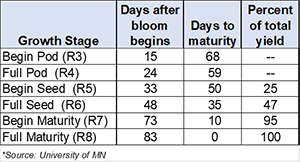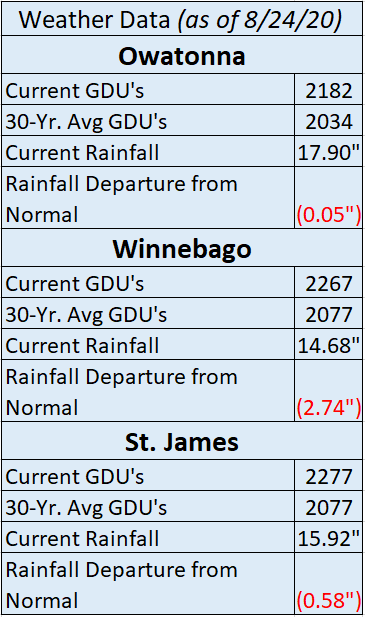2020.08.26 Growing Insights
Aug 26, 2020

|
|||||||
| Predicting Soybean Maturity | |
| Driving across southern MN, soybeans are starting to turn yellow in spots due to disease, stress, SDS, potassium deficiency, and even some due to natural senescence in the earliest relative maturities. Corn maturity is much easier to predict based on growth stage and heat units, but soybeans are more of a challenge. Estimating when soybean maturity will occur is much more difficult as soybean sensitivity to day length speeds up the maturity process as it nears maturity. R7 growth stage is marked by pods beginning to turn to mature color, and dry matter accumulation is complete in the seeds and moisture starts to decrease rapidly. Data from Iowa State University details that it takes about 12 days for soybeans to reach 13% seed moisture after R8 (physiological maturity and 95% of the pods have reached their full mature color), but temperature and humidity can swing the number of days quickly. Below is a rough estimate on days to maturity and percent of total yield of soybeans as you begin to plan harvest season.  |
|
|
|
| Corn Yield Estimates | |
| Yield is a simple equation and comes from the number of (ears per acre x number of kernel rows per ear x number of kernels per row) / kernels per bushel. The first three factors of yield are really easy to measure, and you can do it standing in the field. Weight per kernel, or kernels per bushel, is the big swing factor. We often use 90,000 kernels per 56-lb bushel as an estimate for fast yield estimates. Remember, actual kernel numbers and hybrids can vary from 65,000 kernels per bushel to 120,000 kernels in drought-stressed areas. As you take yield estimates, keep in mind that if yields seem “off,” weight per kernel will have the final say on yield! | |
|
|
 |

